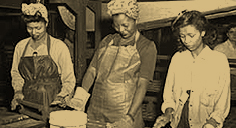Since our founding in 1903, we have established ourselves as a premier American employer by supporting equitable and inclusive employment practices years before the law required it.

Today, we continue to attract a highly skilled and committed workforce that reflects a broad spectrum of culture, ethnicity, race, perspective, age, religion, physical ability and sexual orientation.
The Early Days of Ford
From the beginning, we have always taken steps to ensure our workforce reflects the communities in which we do business.
Milestones demonstrating our commitment to creating a diverse workforce include the following:
- 1913: Henry Ford's offer to pay $5 a day, roughly twice the industry average, attracts thousands of immigrants and African-Americans, helping them to become part of the American middle class
- 1916: Ford's workforce includes people who represent 62 nationalities, as well as more than 900 people with disabilities
- 1918: Long before race relations is a common concept, Ford hires race-relations experts to promote a tolerant work environment
- 1919: Ford begins to hire disabled veterans returning from World War I, making the automaker one of the first companies to hire people with disabilities and to adapt work environments to their specific needs
1920s—1940s
Through the next three decades, Ford continued its policies of equal opportunity and treatment. Significant events include creation of the company's first official non-discrimination clause.
- 1920: Ford Motor Company employs more African-Americans than any other automotive company. In addition, the company also hires its first Asian Indian employee, who went on to establish Ford of India, opening the door for many Asian Indians in the Ford workplace
- 1924: The company hires its first African-American salaried employee and promotes the first African-American employee to plant foreman
- 1941: Ford negotiates its first collective bargaining agreement with the United Auto Workers (UAW). The agreement is groundbreaking because it explicitly prohibits discrimination based on "race, color, national origin or creed," a clause that has remained in every subsequent agreement
- 1946: Gender is added to the UAW-Ford non-discrimination clause. The change is prompted by the entry of women into the Ford workforce during World War II
1950s—1970s
The middle decades produced a number of firsts, including the first African-American and the first woman executive. Under the direction of Henry Ford II, an outspoken advocate for minority rights, the company experienced progress in its diversity efforts throughout the mid-century.
1980s, 1990s and Today
Efforts throughout the latter part of the century expanded the definition of diversity and focused on respect and inclusion. The majority of Ford employees worldwide have participated in skill-building workshops that teach and encourage sensitivity, respect and communication in the workplace.
Employee Resource Groups (ERGs) were endorsed by the company in the early 1990s. The ERG network now includes thousands of employees in 10 active organizations:
- Ford African Ancestry Network
- Ford Hispanic Network Group
- Ford Asian Indian Association
- Ford Chinese Association
- Ford ERG for Gay, Lesbian, Bisexual and Transgender Employees
- Ford Parenting Network
- Ford Interfaith Network
- Middle Eastern Community @ Ford
- Ford Employees Dealing with disAbilities
- Professional Women's Network
By 2000, the company had expanded its definition of diversity to include not only race, ethnicity, age and gender, but also many things that make people unique: backgrounds, opinions, experiences, perspectives and life situations.
Today, the company puts an emphasis on fostering an inclusive culture that is free of barriers, and in which all employees feel comfortable, valued and able to contribute to their fullest, in order to build high-performing, collaborative teams across its global business. This inclusion of diverse perspectives within Ford will help to effectively deliver innovative products that satisfy customers' wants, needs and desires.

